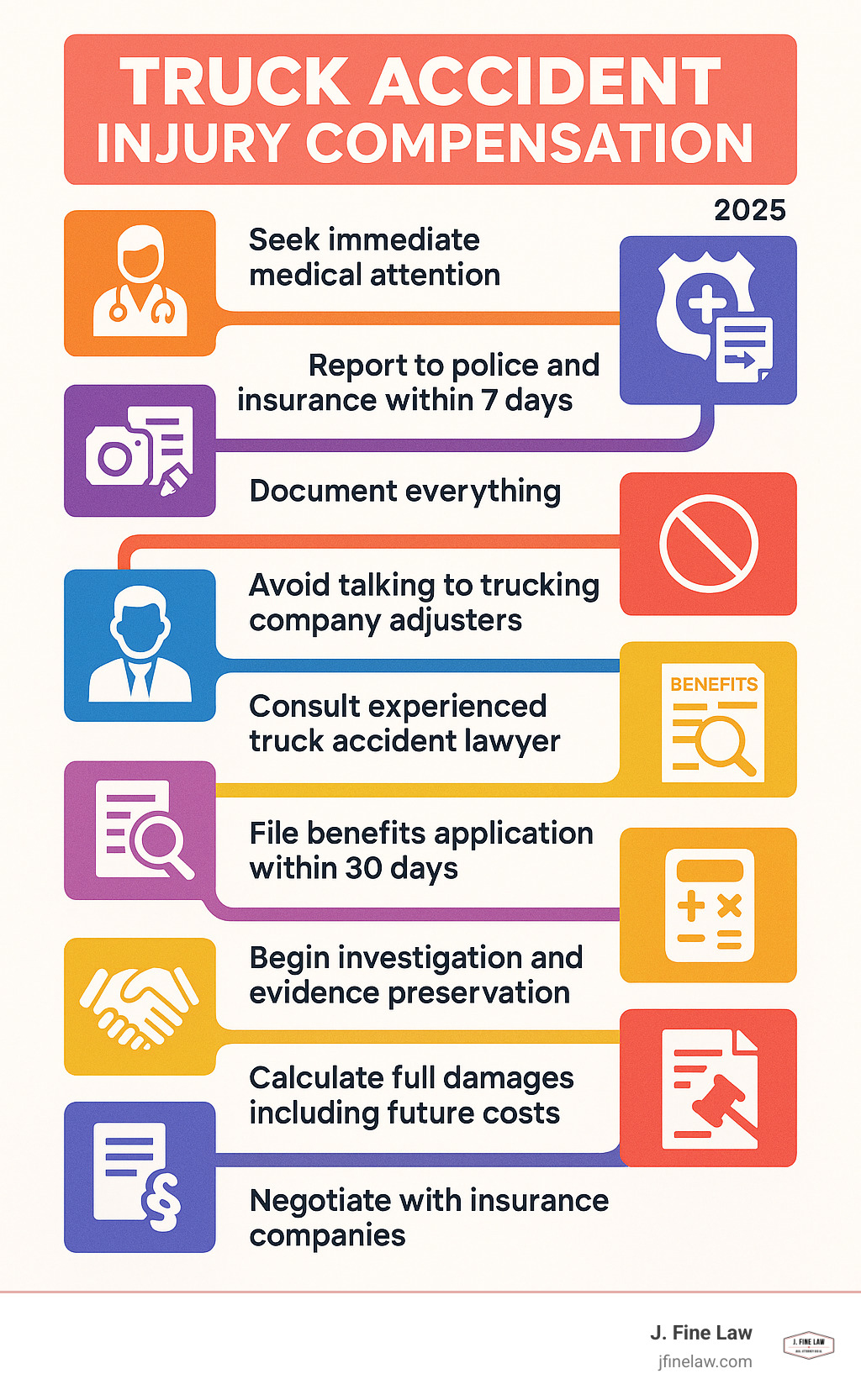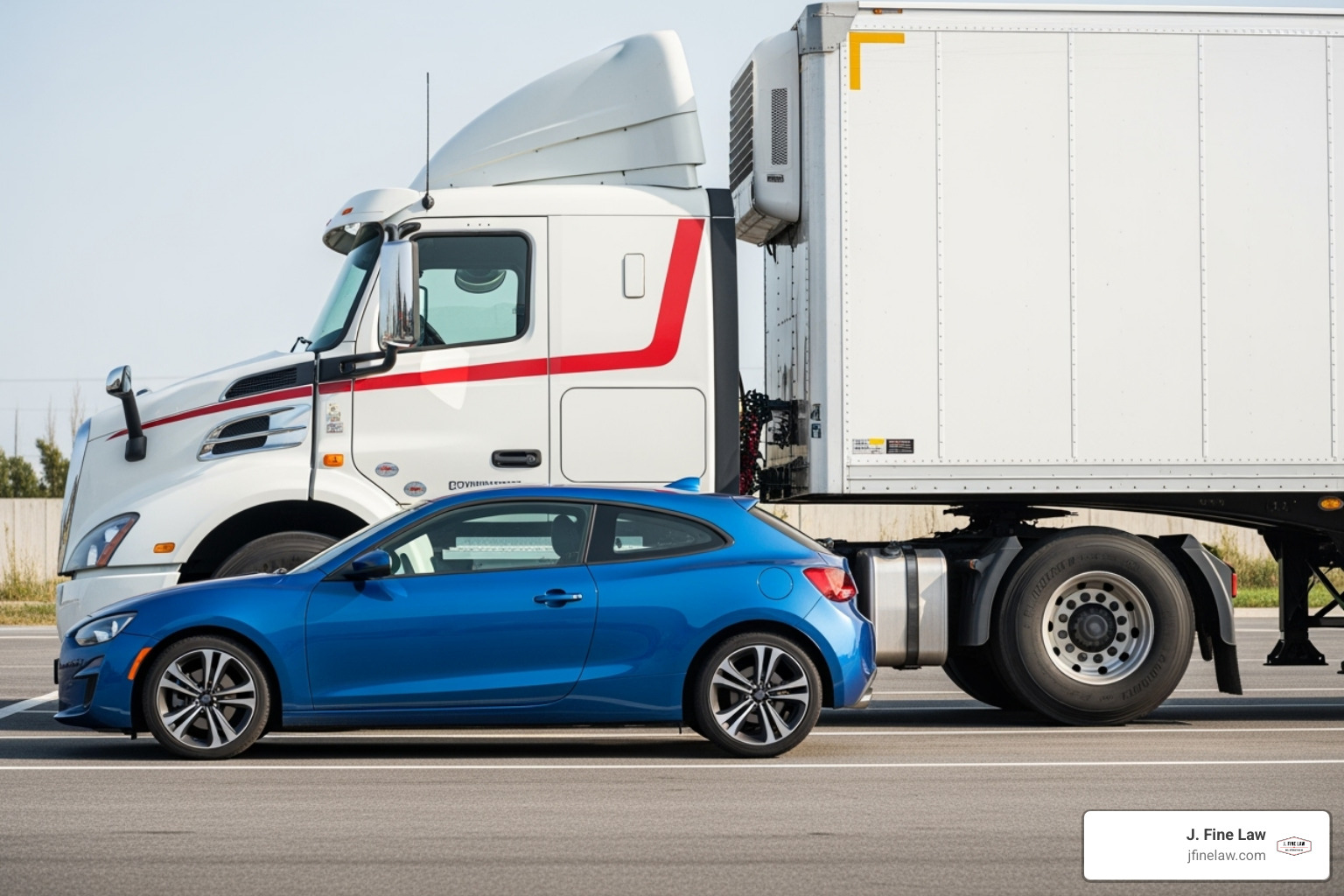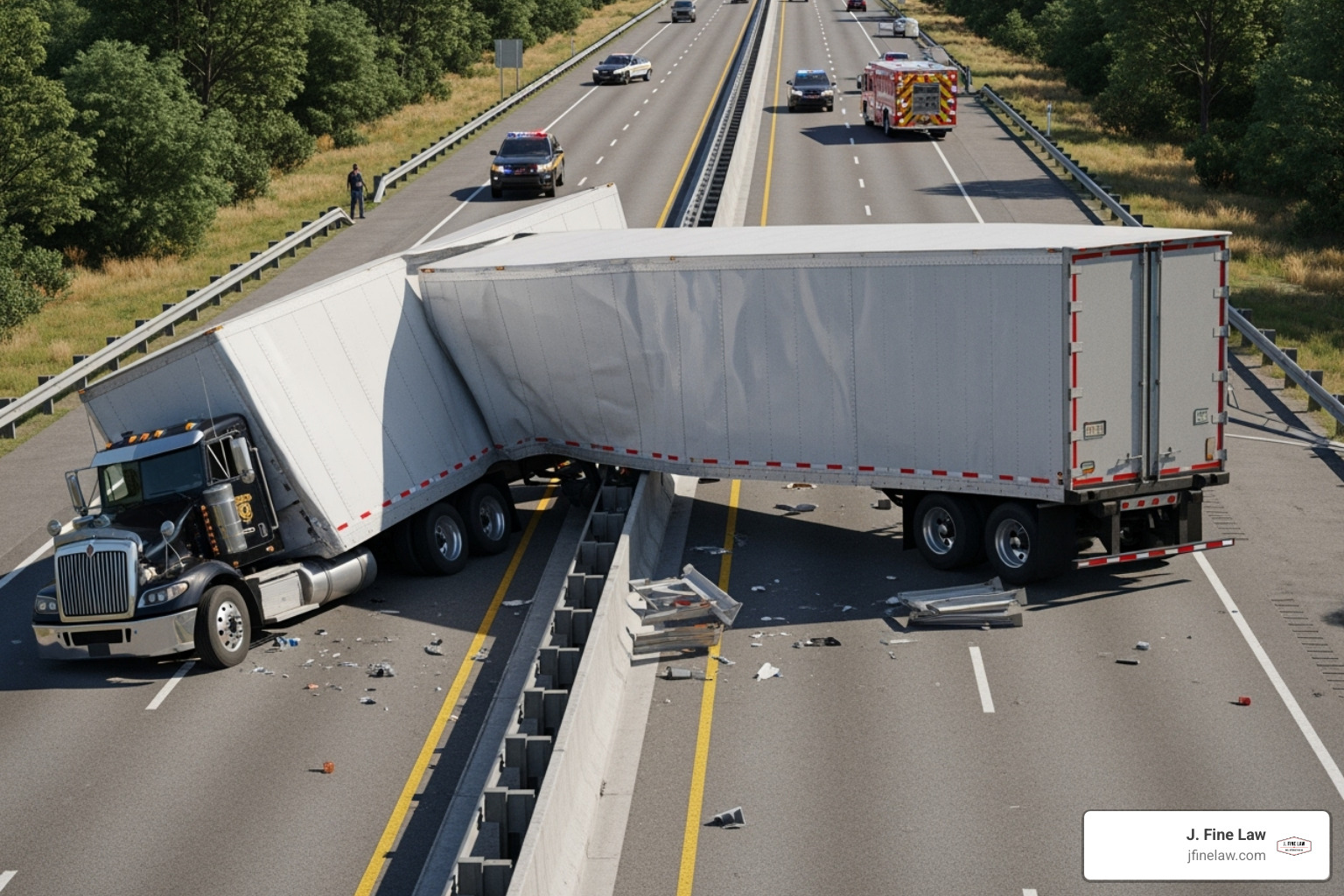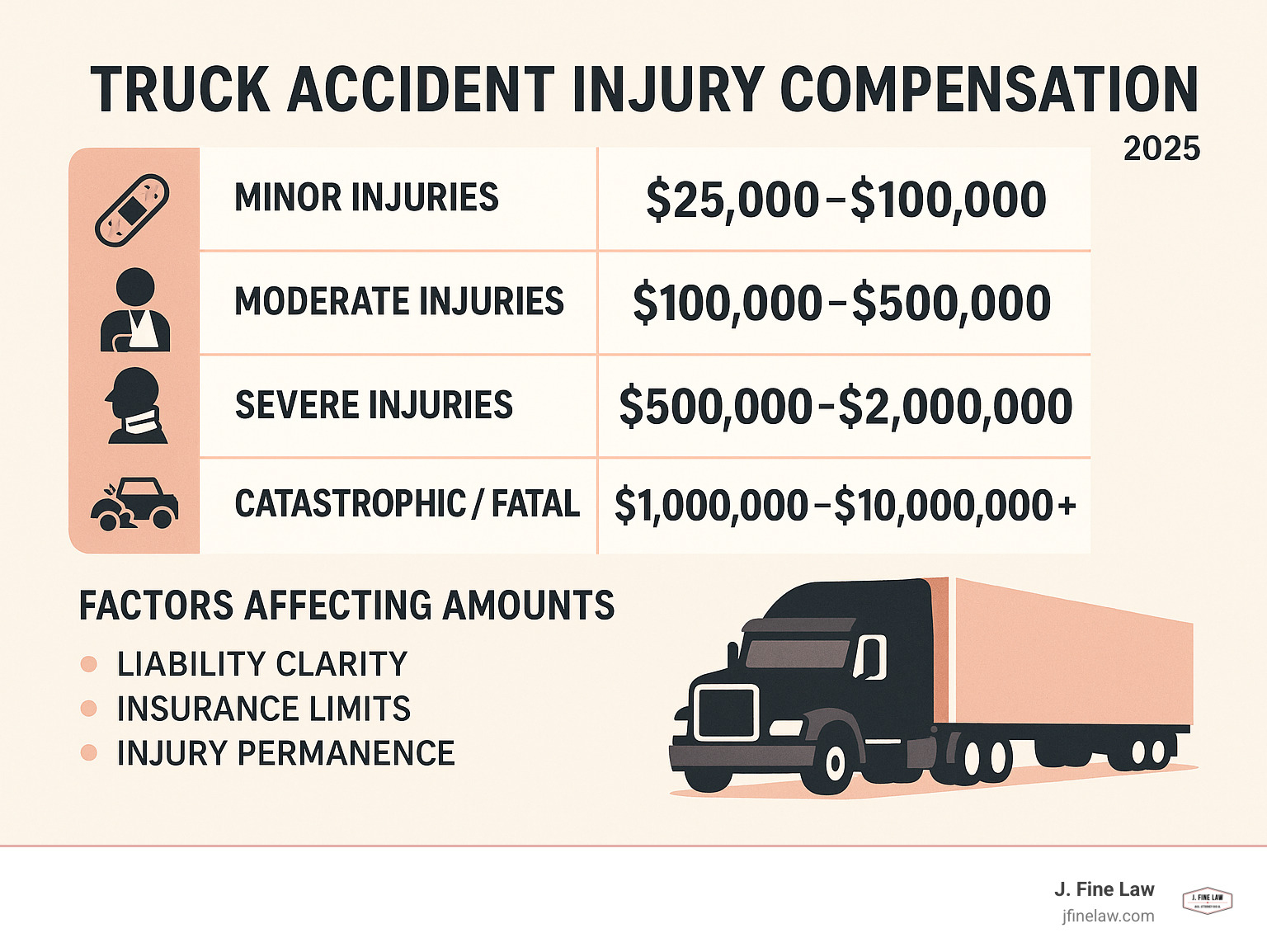The High Stakes of a Truck Accident
Truck accident injury compensation can cover medical costs, lost wages, pain and suffering, and future care.
Key Types of Compensation:
- Economic Damages: Medical bills, lost income, property damage
- Non-Economic Damages: Pain and suffering, emotional distress, loss of enjoyment of life
- Punitive Damages: Extra money for gross negligence (rare)
Average Settlement Ranges:
- Minor injuries: $25,000 – $100,000
- Moderate injuries: $100,000 – $500,000
- Severe injuries: $500,000 – Several million dollars
Critical Deadlines:
- Report to insurance: 7 days
- File benefits application: 30 days
- Lawsuit: 2 years from the accident
A tractor-trailer can weigh 40 tons; the average car about 3,000 pounds. That size gap explains why truck crashes often lead to catastrophic injuries and why the legal fight for compensation is much tougher than an ordinary fender-bender.
Commercial insurers have teams whose only job is to pay as little as possible. You need someone who knows how to make them pay what your claim is really worth.
I’m Jason Fine, a Pennsylvania Super Lawyer. Over 25 years I’ve recovered more than $50 million for crash victims, including a $2.5 million settlement for a client who suffered burns and fractured ribs in a commercial vehicle collision.
Key terms to know:
Why Truck Accidents Are More Complex Than Car Accidents
A truck crash isn’t just a bigger car crash—it’s a different animal entirely. The physics, regulations, potential defendants, and insurance limits all multiply, creating a far more challenging legal landscape for victims.
The Physical Impact: Size and Force
A fully loaded 18-wheeler can weigh 80,000 lbs—more than 25 times a passenger car. The laws of physics are unforgiving in these collisions. The immense force generated means that even at relatively low speeds, the impact can be devastating, leading to traumatic brain injuries, spinal cord damage, multiple fractures, and, tragically, wrongful death. Statistics consistently show that the occupants of the smaller passenger vehicle bear the brunt of the physical harm, with 86% of fatalities in large-truck collisions being those in the other vehicles.
The Legal Labyrinth: Regulations and Liability
Trucking is a heavily regulated industry for a reason. Trucking companies and their drivers are governed by a dense web of federal and state regulations, primarily enforced by the Federal Motor Carrier Safety Administration (FMCSA). These aren’t mere suggestions; they are legally mandated safety standards. Key regulations include strict hours-of-service (HOS) limits to prevent driver fatigue, detailed pre-trip and post-trip inspection requirements, specific protocols for securing different types of cargo, and the mandatory use of Electronic Logging Devices (ELDs) to track driving time accurately. A violation of any of these rules—such as a driver exceeding their 11-hour driving limit or a company failing to repair a known brake issue—can serve as powerful evidence of negligence, directly linking the breach of duty to the cause of the crash.
Key differences from car cases:
- Multiple defendants: Unlike a typical car crash with one at-fault driver, a truck accident can involve the driver, the trucking company (carrier), the cargo loader, the maintenance shop, and even the manufacturer of a faulty part.
- Massive insurance policies: Federal law mandates high liability insurance coverage for commercial trucks, often ranging from $750,000 to over $5 million, which means the stakes are higher and insurers fight harder.
- Perishable electronic data: Crucial evidence like black box data and driver logs can be overwritten or legally destroyed if a preservation letter is not sent immediately.
Because of these layers, truck accident injury compensation cases demand specialized legal experience to steer the complexities and hold all responsible parties accountable.
Common Causes of Truck Accidents and Determining Fault
Most truck crashes trace back to preventable human or mechanical errors. Identifying the specific cause is the first step in building a strong claim for compensation.
- Driver fatigue: To combat this danger, the FMCSA enforces strict hours-of-service (HOS) rules. For example, a property-carrying driver may drive a maximum of 11 hours after 10 consecutive hours off duty. Violations, often revealed by analyzing the truck’s ELD data, are a clear sign of negligence by both the driver and the company that may have encouraged or overlooked the infraction.
- Distracted driving: This goes beyond cell phones. Truck drivers may be distracted by dispatching devices, GPS units, eating, or adjusting controls. Any activity that takes their eyes, hands, or mind off the task of driving can be catastrophic.
- Speeding: A truck traveling at high speed needs a much longer distance to stop than a car. Speeding, or simply driving too fast for weather or traffic conditions, dramatically increases the risk of a high-impact collision.
- Poor maintenance: Commercial trucks require constant, meticulous maintenance. Brake systems, tires, steering components, and lights must be regularly inspected and repaired. A failure in any of these systems, especially a catastrophic tire blowout or brake failure on a downgrade, can be devastating. Investigation often uncovers skipped maintenance schedules or failure to address issues noted in driver inspection reports.
- Improper cargo loading: If cargo is overloaded or improperly secured, it can shift during transit, causing the driver to lose control or the truck to roll over. The weight distribution is critical to the truck’s stability.
- Unsafe driving in bad weather: While bad weather isn’t anyone’s fault, professional drivers are held to a higher standard and are expected to adjust their driving, slow down, or even pull over if conditions become too hazardous.
Who Can Be Held Liable?
Fault is rarely limited to just the driver. We investigate every potential defendant to maximize your recovery:
- Truck driver: For direct negligence like speeding or distracted driving.
- Trucking company: For negligent hiring, poor training, lax supervision, or encouraging HOS violations.
- Parts or vehicle manufacturer: If a defective tire, brake system, or other component caused the crash.
- Cargo loader or shipper: If improperly loaded or secured cargo led to a loss of control.
- Maintenance contractor: If a third-party company performed shoddy repairs or failed to identify a critical safety issue.
- Government agency: In some cases, a poorly designed or maintained road can be a contributing factor.
Investigating the Crash
Full compensation depends on a fast, thorough investigation that goes far beyond the initial police report. Our process includes:
- Securing and analyzing ELD/black-box data.
- Scrutinizing the driver’s qualification file, training records, and drug/alcohol testing history.
- Reviewing all maintenance, inspection, and repair records for the truck and trailer.
- Researching the trucking company’s safety rating and history of violations.
- Working with top accident-reconstruction experts to scientifically prove how the crash happened.
Evidence disappears quickly, so we send preservation letters immediately to lock down all critical information.
Understanding Your Truck Accident Injury Compensation
Compensation is meant to restore you—financially and personally—to where you would have been had the crash never happened.
Types of Damages
| Damage Type | Covers | Examples |
|---|---|---|
| Economic | Out-of-pocket costs | Medical bills, lost income, property repair |
| Non-Economic | Quality-of-life losses | Pain, emotional distress, loss of enjoyment |
| Punitive | Punish egregious conduct | Rare, but possible for willful safety violations |
Economic vs. Non-Economic
We total every dollar you have spent or will spend: ER care, surgeries, therapy, prescriptions, adaptive equipment, transportation, home modifications, lost wages and reduced earning capacity.
Then we calculate non-economic damages—often the largest part of a settlement—using respected methods such as the multiplier approach, life-care-plan testimony and comparable verdict research.
No-Fault (PIP) Benefits
In Pennsylvania and New Jersey, your Personal Injury Protection pays initial medical bills and a portion of lost wages regardless of fault. These benefits keep the lights on while we pursue the much larger claim against the at-fault trucking parties. Your choice of “limited tort” or “full tort” coverage may affect pain-and-suffering claims; we’ll explain the differences during your consultation.
The Legal Process: Deadlines and Why a Lawyer is Crucial
In a truck accident claim, the clock starts ticking the moment the crash occurs. Missing a deadline can permanently bar you from recovering any compensation, no matter how severe your injuries are.
- 7 days: Notify your own auto insurer and put the trucking company’s insurer on notice of a potential claim.
- 10 days (government defects): If a poorly designed or maintained road contributed to the crash, you may have an extremely short window to provide formal written notice to the responsible government entity.
- 30 days: You must submit your application for Personal Injury Protection (PIP) benefits to your own insurer to get your initial medical bills and lost wages paid.
- 2 years: This is the statute of limitations in both Pennsylvania and New Jersey for filing a personal injury lawsuit. While it seems like a long time, a thorough investigation can take many months.
These are not flexible guidelines; they are hard deadlines. An experienced lawyer ensures every notice is filed correctly and on time.
How We Maximize Your Recovery
- Immediate Evidence Preservation: The most critical evidence in a truck accident case is electronic and can be deleted, sometimes automatically, within days or weeks. This includes the truck’s “black box” (Electronic Control Module) data, the driver’s Electronic Logging Device (ELD) records, and GPS tracking information. We immediately send a formal “spoliation letter” to the trucking company, legally obligating them to preserve this data and the physical truck itself. Failure to do so can result in severe court sanctions against them.
- Expert-Driven Case Building: We work with a network of top-tier experts to build an undeniable case for damages. This includes accident reconstructionists to prove fault, medical specialists to detail the extent and future consequences of your injuries, vocational experts to establish lost earning capacity, and economists to calculate the full lifetime cost of your losses.
- Aggressive Negotiation and Litigation: Armed with overwhelming evidence, we negotiate with the trucking company’s billion-dollar insurers from a position of strength. They know we are prepared to take the case to trial and win. If they refuse to offer a fair settlement that covers all your past, present, and future needs, we do not hesitate to file a lawsuit and fight for you in court.
Our 98 % success rate and more than $50 million recovered show why early, experienced representation makes a multi-million-dollar difference.
Frequently Asked Questions about Truck Accident Claims
What is the average settlement for a truck accident?
There is no single “average” settlement, as each case is unique. The value is driven by the specific facts, including the severity of your injuries, the clarity of fault, and the available insurance policy limits. However, settlements generally fall into these ranges:
- Minor injuries: $25,000 – $100,000
- Moderate injuries: $100,000 – $500,000
- Severe injuries: $500,000 – $2,000,000+
- Catastrophic / wrongful death: $1,000,000 – $10,000,000+
We have obtained results like $1 million for a client requiring back surgery and $2.5 million for a victim who suffered severe burns and multiple fractures. The ultimate value of your claim depends on a thorough calculation of all your economic and non-economic damages.
How long will my case take to resolve?
The timeline for a truck accident case varies significantly based on its complexity. Factors that influence the duration include the severity of your injuries and the time it takes to reach Maximum Medical Improvement (MMI), the number of defendants involved, whether liability is disputed, and the extent of the formal “findy” process, which involves exchanging documents and taking depositions.
- Clear-liability, minor-injury cases: Can often be resolved in 6–12 months.
- Contested or multi-defendant cases: Typically take 18–36 months.
- Catastrophic-injury cases requiring litigation: May take 2–5 years to reach a final resolution.
We prioritize moving your case forward efficiently but will never recommend a quick, lowball settlement when a more patient, thorough approach is necessary to secure the full compensation you deserve.
What if I was partly to blame for the accident?
Both Pennsylvania and New Jersey use a “modified comparative negligence” rule. This means you can still recover damages as long as you are found to be 50% or less at fault for the accident. Your final compensation award will be reduced by your percentage of fault. For example, if you are awarded $1,000,000 but found to be 10% at fault, your recovery would be reduced by $100,000, for a net award of $900,000. Insurance companies will often try to shift as much blame as possible onto the victim. A thorough investigation is crucial to counter these tactics and accurately establish the truck driver’s and trucking company’s much larger share of the fault.
Secure the Compensation You Deserve
A trucking carrier’s legal team is already working to limit its exposure. Let us start fighting for you before critical evidence disappears and deadlines expire.
At J. Fine Law we focus on truck crashes in Pennsylvania and New Jersey. Our record: 98 % success, $50 million+ recovered, rapid attorney response.
Book a free consultation today—no fee unless we win. The sooner you call, the stronger your case and the greater the chance of full recovery for your medical bills, lost income and lifelong needs.






